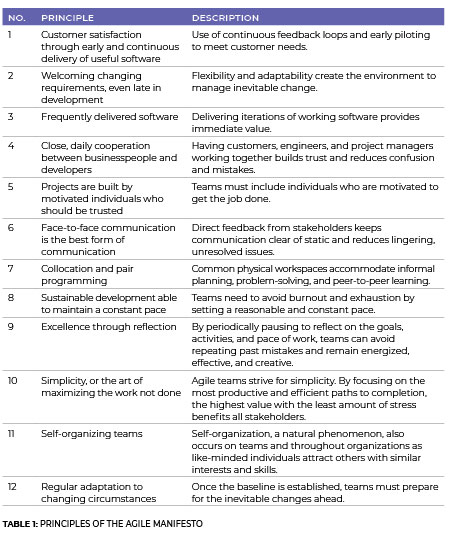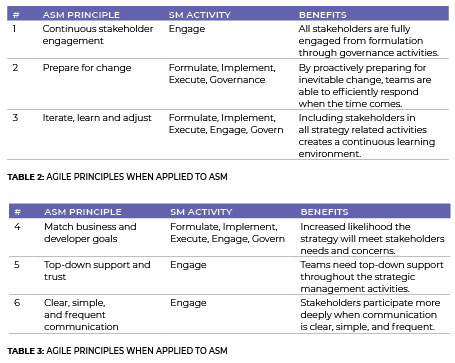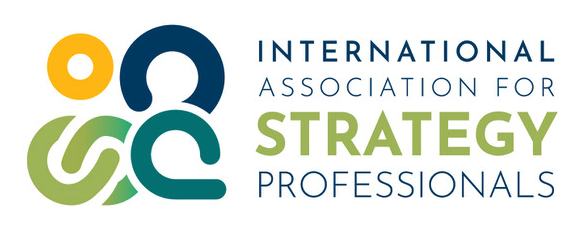By Gerry Starsia
ABSTRACT
With its roots in the scientific method in the 20th century, early Strategic Management can be described as a linear way to manage. It evolved into more adaptive and emergent forms in the mid-late 20th century as organizations grew in complexity, size, and scale, and most recently is at a critical point in its usefulness. As leaders and managers strive to keep up with the dynamic conditions of the present, how will strategic management adapt, adjust, and transform? The objective of this paper is to present the principles of the Agile Manifesto and explain how they can be applied to strategic management resulting in a new way to manage: Agile Strategic Management.
With its roots in the scientific method in the 20th century, early Strategic Management can be described as a linear way to manage. It evolved into more adaptive and emergent forms in the mid-late 20th century as organizations grew in complexity, size, and scale, and most recently is at a critical point in its usefulness. As leaders and managers strive to keep up with the dynamic conditions of the present, how will strategic management adapt, adjust, and transform?
To cope in this complex and dynamic world, organizations can either develop entirely new ways of doing business that are untested, or they can look to practices that have worked in the past, are reliable, and can be re-formed as needed. Adapting agile practices is one such approach. The objective of this paper is to present the principles of the Agile Manifesto and explain how they can be applied to strategic management resulting in a new way to manage: Agile Strategic Management.1
What is Agile Strategic Management?
Strategic Management is the managing of an organization’s resources to achieve its goals and objectives. It includes the continuous cycles of strategy-related activities for an organization to succeed in the long-term.2 These activities can be categorized into five important groups: Formulate, Implement, Execute, Engage, and Govern.3 In the formulate group of activities, strategy is determined by scanning internal and external environments, analyzing relevant data, and then matching the analysis and findings to strategic goals. In the implement group of activities, the organization is transformed so that the operating capacity and core competencies are matched with the strategy. In the execute group of activities, the primary and secondary activities are executed in perfect alignment to the strategy so the organization can deliver value to its stakeholders. In the engage group of activities, leaders communicate the strategy, explain the priorities, build staff commitment, remove barriers, and lead the way forward. In the govern group of activities, leadership, including board members, executives, staff, and teams, closely monitor internal and external feedback and prepare to make strategy adjustments as needed. These activities form a cycle of continuous strategy by scanning markets, evaluating customer experiences and satisfaction, supporting development teams, and adjusting or pivoting the strategy along the way.
In turn, agile can be defined as an iterative approach to project management that aligns development activities with changing business requirements.4 The Agile Manifesto is an approach to project management created in 2001 by a small group of software developers for use as an alternative to the traditional waterfall software development method.5 The 12 principles of the Agile Manifesto (Table 1) evolved as a method for managing teams and projects.
The combining of the principles of agile management and strategic management activities results in the formation of a new and compelling approach to managing organizations: Agile Strategic Management (ASM). ASM is the adaptation of familiar, battle-tested management approaches and principles that, when integrated in a new way, helps managers deal with unprecedented complexity and dynamism. As managers move from projects to executive-level responsibilities, their worlds get increasingly complicated. Rather than inventing new ways to work, it makes sense to reach out for ones that can be adapted to these new environments.6

Operationalizing Agile Strategic Management
The principles of the Agile Manifesto can be applied to strategic management as follows.
Principles 1, 2 and 3: Focus on the customer and prepare for change
Common to strategic management, and a key component of agile, is the focus on continuous stakeholder engagement (Principle 1). Through a continuous feedback loop, starting in the formulation phase, strategic initiatives need to be designed to meet stakeholders’ needs, solve a problem, and/or drive ROI. One way to accomplish this is by including the customer in the planning process, designing solutions or new products that meet business goals, and then including customers in the implementation and governing phases so their interests are always top of mind. In an example from higher education, an inventor/scholar was invited onto a strategic initiative team to share his vision and business case for a software based, diagnostic tool. Together they detailed the requirements during strategy formulation and then piloted and tested the software with users during strategy implementation (Principles 1 & 3).
Another area that is common to both strategic and agile management is the need to prepare for change (Principles 2). Throughout the formulation, implementation, execution, and govern activities, organizations and project teams need to accept that business cases and environments change. They need to welcome change, remain flexible, and adjust as conditions and demands evolve (Principles 1 & 2). In the strategic initiative project referred to above, with changes to base requirements on an almost daily basis, the team focused one group on core functionality while another on analyzing and integrating user feedback into new releases.
While iteration is often related to software development, there are aspects of strategic management that are similar (Principle 3). Agile advocates agree that in the execution phase, it is better to deliver working software iteratively, and make incremental improvements based on user feedback, rather than take a much longer time to deliver the “perfect final product” (Principles 2 & 3). The same goes for all strategy management activities. For example, in executing their strategies, a manufacturing firm and a building company in the Northeast US collaborated by sharing schematic designs. Mock-ups were built and feedback collected from customers and users.

Principles 4, 5 and 6: Building Teams and Trust
It is critical for development teams to match strategic goals with the business interests of the stakeholders (Principle 4), for leaders to support the team (Principle 5), and for all stakeholders to communicate together frequently and effectively (Principle 6).7 By assembling stakeholders in the formulation, implementation and execution phases, trust is established, teams are motivated and empowered, processes remain simple, and communication clear reducing confusion, mistakes, and frustration (Principles 5 & 6).8 In a recent discussion with a medical software development team, doctors and nurses collaborated in the development of the specifications and user experience goals to ensure a teleradiology initiative met the needs of both the medical team and their patients (Principle 4). In another example, the strategy implementation teams of a US manufacturer of heavy equipment controls included customers and operators in all phases of the design and testing of new components.9 The frequent and continuous communication minimized issues and maximized productivity (Principles 4, & 6).
Principles 7, 8, 9 and 10: Sustainable Development at a Constant Pace
The ASM principles of delivering value (Principle 7) and speed and consistency (Principle 8) are intertwined. Once the strategy formulation is complete, progress is achieved through a process of continuous field testing, implementation, iteration, and improvement. In the quest for completion, teams can get caught up in this continuous development cycle with the potential for burnout and exhaustion. Leaders can mitigate these effects by setting a reasonable work pace and avoiding the around-the-clock, “must have it by tomorrow” syndrome (Principle 8). For an extreme sports storage company, using agile techniques to pilot new designs allowed the team to move quickly and efficiently from formulation to execution, and from idea to launch.
Through a combination of technical and design excellence, and attention to quality, teamwork, and simplicity, requirements move from formulation to execution seamlessly and efficiently (Principles 8 & 10). Maintaining this balance is a nuanced process that requires attention to details, intuition, and business savvy (Principle 9). In an example from a large construction project, the owner, builder, and end-users worked together to design the project and manage the budget in a side-by-side, continuous process, weighing cost and business case against specifications and quality.
Principles 11 and 12: Looking back to look ahead
As projects and strategic initiatives wind down and teams reach the point of exhaustion, making time for self-reflection and assessment (Principle 12) is often forgotten, or avoided, and as a result, valuable lessons are lost. An important aspect of good governance, high-performing and often self-organizing teams need to step back from tasks and assess strategy, goals, and progress (Principles 11 & 12). A retrospective at key points along the timeline and documenting issues helps avoid repeating past mistakes. At one large multinational non-profit organization, weekly stand-ups, monthly performance reviews, and quarterly strategy assessments are used to stay on track, gain critical feedback, and record both the highlights and challenges, or what worked and what mistakes were made.
Conclusion
The relationship between the Agile Manifesto and Strategic Management theory and practice, is clear.10 By applying an agile lens to management, organizational directors, partners, leaders, and managers can stay focused on activities likely to have the most impact and avoid others that return little to no value. Building smart teams, creating flat, responsive feedback loops, scanning for external change, and preparing to pivot away from unproductive activities and towards those with high ROI, are among the key tenets of Agile Strategic Management.
REFERENCES
1 Starsia, G. (2022) Plan to pivot: Agile organizational strategy in an age of complexity. Morgan James Publishing.
2 Association of Strategic Planning. (2022) Book of knowledge 3.0.
3 Hadaya, P., & Gagnon, B. (2020) Mapping an agile future. Strategy Magazine, 35, p.18-21.
4 Association of Project Management (2021) What is agile project management? APM.org.uk.
5 Beck, et. al. (2001) Twelve principles of the agile manifesto. Agilemanifesto.org
6 Edmondson, M. (2020) Agility: Management principles for a volatile world. Business Expert Press.
7 Hayward, S. (2021) Agile leader: How to create an agile business in the digital age. Kogan Page.
8 Stadler, C., Hautz, J., Matzler, K.,
& von den Eichen, S. (2020) Open up your strategy. MIT Sloan Management Review, December 20.
9 Simons, S. (2021) Interview. Charlottesville, Virginia.
10 Tilman, L., & Jacoby, C. (2019) Agility: How to navigate the unknown and seize the opportunity in a world of disruption. Missionday, Publishers Group West.
ABOUT THE AUTHOR
Gerry Starsia served as the Senior Associate Dean and Chief Operating Officer at the University of Virginia’s McIntire School of Commerce and Darden School of Business and is currently Associate Professor of Higher Education. He recently published a book, Plan to Pivot:
Agile Organizational Strategy in an Age of Complexity.
Prior to his tenure at UVA, he worked in the real estate development industry as Founder/CEO, project manager, and consultant. Gerry lives in Charlottesville, Virginia, In the US.







